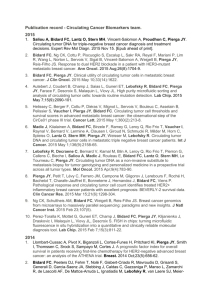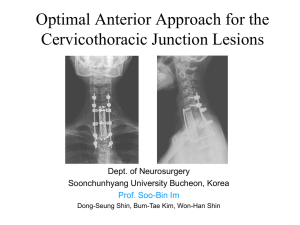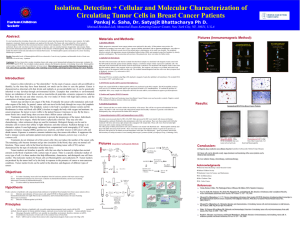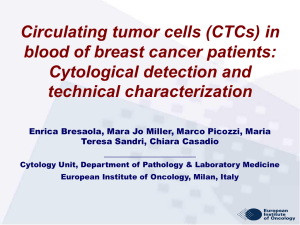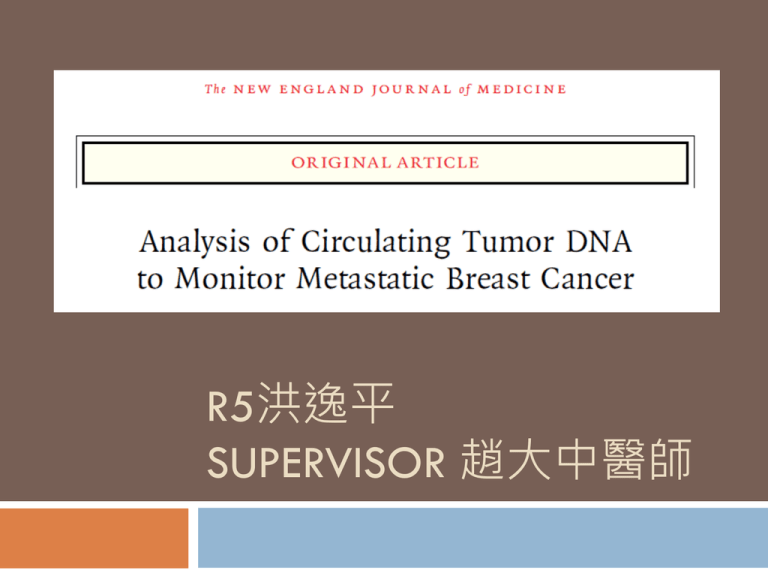
R5洪逸平
SUPERVISOR 趙大中醫師
Breast Cancer
The most prevalent
cancer in female
Mortality 4th in Taiwan
Treatment of Breast Cancer
Breast Cancer
When to change regimen?
Unacceptable
toxicity
Progression disease
Current Tools for Follow-up
Radiologic image
Standard serologic test
Circulating soluble-tumor–associated protein
biomarkers
Circulation tumor cells
Circulating tumor DNA
Radiologic image
Expensive
Time consuming
Inconvenient
Inconclusive
May not informative in several months
Reasonably sensitive, not always reflect tumor
response or progression
Standard serologic test
Such as AST and ALT, LDH
Inaccurate
Circulating soluble-tumor–associated
protein biomarkers
CEA, CA 15-3
CA 15-3, soluble forms of
MUC(cell surface associated )-1 protein
J Clin Oncol 2007 25:5287-5312.
Circulation tumor cells
In 2004, pts with fewer CTC lived longer than with
N Engl J Med 351(8):781–791.
more CTC
177 Pts with metastatic breast cancer
Annals of Oncology 22: 86–92, 2011
CTCs and tumor markers in Breast
Cancer
IC 2006-04 enrolled prospectively 267 metastatic breast
cancer pts.
Breast Cancer Research 2012, 14:R29
Circulation tumor DNA
Circulating tumor DNA
In a study in China, 46 of 126 primary breast
cancer pts have p53 mutation in the peripheral
blood
Clin Cancer Res 2001;7:2222-2227
Circulating tumor DNA
Specific mutation and structural variation in primary
tumor cell
142 breast cancer pts ( not disseminated) was
analyzed at diagnosis
Clin Cancer Res 2002;8:3761-3766.
Method
Prospective, single-center study
Compare circulating tumor DNA, CA 15-3, circulating
tumor cell
Tagged-amplicon deep sequencing for PIK3CA
(encoding the phosphatidylinositol-4,5-bisphosphate 3kinase, catalytic subunit alpha protein) and TP53
(encoding tumor protein p53) or paired-end wholegenome sequencing
p53 mutations are found in 50–75% of breast carcinoma
patients
Science (Wash. DC), 253: 49–53, 1991.
Serial blood samples(30ml) every 3 or more weeks
Identification of Genome Alteration
Tagged-amplicon deep
sequencing
Paired-end whole-genome
sequencing
mutation
22
3
SV
5
CA 15-3 vs ctDNA
CTCs and ctDNA
Result
Result
Result
Quartiles of ctDNA and OS
ctDNA, CTCs and Relative Hazard
Conclusion
Circulating tumor DNA shows superior sensitivity and
has a greater dynamic range that correlates with tumor
burden
Circulating tumor DNA provide earliest measure of
treatment response
Identification of somatic alteration is needed
Target sequencing could be expanded in addition to
PIK3CA and TP53 when the cost reduced
There are many ways to identify tumor DNA : digital
PCR assay, targeted deep sequencing, exome
sequencing, BEAMing, Safe-SeqS…
Future
Target like BCR/ABL may be found and develop
new target therapy!!
Thanks for Your Attention!!







